December 23 - 29, 2012: Issue 90
Bellemere-Melrose + The Green Frog at Church Point: Pittwater Summer Houses
Sources state the plot of land on which this cottage and boarding house was built was purchased from William Henry McKeown, in 1888, other sources refer to Benjamin James (1845- 1908) as the gentleman who built the original residence, the three bedroom cottage and lived there from 1888. On 4 February John Redman of Pittwater purchases 23 acres at Church Point on the point overlooking Pittwater from Jane James (nee Buist), the wife of Benjamin James (married 1868). Formerly the land was part of William Oliver’s land grant of 66 acres. On this property was a 3 room weatherboard cottage. After his death, the land now 17 ¼ acres, not 23 acres, is advertised for Auction on 15 August 1888. (SMH 13 August 1888 P.11)
The property is purchased by William G Baker and his wife Edith Maude Baker prior to 1890. Their tenure was very short, perhaps because tragedy struck;
A farmer named William Baker, residing at Pittwater, was kicked in the abdomen by a horse a week ago. He was attended to during last week by Dr. D. R. Edwards, of Manly, but succumbed to the injury received on Saturday night. NEWS IN BRIEF. (1889, March 23). Australian Town and Country Journal (NSW : 1870 - 1907), p. 12. Retrieved from http://nla.gov.au/nla.news-article71116686
A FATAL KICK. A magisterial inquiry was held by Mr. W. T. Pinhay, J.P., at Manly, yesterday, into the circumstances attending the death of a farmer named William Baker, who died at the residence of his brother-in-law, Gilbert street, Manly, on the previous evening. The deceased lived at Bay View, Pittwater, and on Sunday week he received a severe kick in the abdomen from a horse. He was taken to Manly and placed under the treatment of Dr. Edwards, but after lingering for a week he succumbed to the injuries received. A verdict of accidental death was recorded. A FATAL KICK. (1889, March 19). The Sydney Morning Herald(NSW : 1842 - 1954), p. 8. Retrieved from http://nla.gov.au/nla.news-article13718008
William was the son of William Joseph Baker, who also had property in Church Point. William G Baker’s widow Edith, whom he married in 1886, had already had a son in 1888, Arthur E Baker. Interestingly, William Baker Snr. and his wife were still having children in 1883;
Births. BAKER.—April 20, at her residence, Pittwater, the wife of William Baker, of a son. Family Notices. (1883, April 25). The Sydney Morning Herald(NSW : 1842 - 1954), p. 1. Retrieved from http://nla.gov.au/nla.news-article13533478
Major Phillip Charley (1863–1937) purchased the property from Mr Bakers widow (1890) and added considerably to a basic cottage. This gentleman was among seven shareholders in the original Broken Hill silver mine and ended up a millionaire. He was renowned for his breeding of horses and bulls and owned extensive properties, the best of these said to be Belmont Park at Kurrajong Heights, on the Hawkesbury. Visiting Pittwater, from the Hawkesbury, he would have appreciated the pristine beauty of Pittwater and Church Point, a primary stop for ferries (The Phoenix). One of his children with wife Clara, Noel G, was born at Manly in 1898, pointing to a long association with the Northern Beaches. His sister Mrs Foster is also purported to have lived there for quite some time. Around 1900 Mrs Codrington took over the residence and ran it as a boarding house, changing the name to ‘Bellemere’;
Mrs. EMMA CODRINGTON and FAMILY, of Bay View, Pittwater, desire to express their sincere GRATITUDE to the medical and nursing staff of Prince Alfred Hospital and kind friends for attention, expressions of sympathy, and floral tributes in their recent bereavement. Family Notices. (1900, February 14). The Sydney Morning Herald (NSW : 1842 - 1954), p. 1. Retrieved from http://nla.gov.au/nla.news-article14294008
LAWS-CODRINGTON-December 4, 1901, at Pitt-street Congregational Church, Sydney, by the Rev. James Trevor Ernest, only son of Percy C. J. Laws, of Mosman, to Olive youngest daughter of the late Hamilton Osbert and Emma Codrington, of Bellemere, Bay View. Family Notices. (1901, December 28). The Sydney Morning Herald (NSW : 1842 - 1954), p. 1. Retrieved from http://nla.gov.au/nla.news-article14450726
It was actually Lucy (born 1880) whom James married. Vincent Lee was the eldest son of Emma and Hamilton Osbert Codrington who died in 1900, her husband having passed in 1883 when Lucy was a mere three years old and Vincet just six. Edith Elizabeth (born 1874) Frances M (born 1872) and John E (born 1878) necessitated the earning of a living by Emma and ‘Bellemere’ was not the only boarding or Guest House she was associated with in Pittwater. More about that in the next issue.
Named ‘Melrose’ by 1906 the premises was then run by a Mrs Friend, in 1908 by Huntley (? possibly owned by Thomas Sellwood Huntley, real estate auctioneers and builder of gasworks water supplies with Walter Barnard; MORE)
BY ORDER OF THE EXECUTORS THE ESTATE OF THE LATE MR. WILLIAM JOSEPH BAKER. ONE OF THE MOST CHARMING SPOTS AROUND SYDNEY. CHURCH POINT, PITTWATER. A pleasant Motor or Coach drive from Manly, through delightful and varied Scenery. SPLENDID SUBDIVISION BLOCK OF ABOUT 30ACRES, PRACTICALLY A WATER FRONTAGE, with LARGE FRONTAGE to the MAIN ROAD, adjoining La Corniche, the well-known Accommodation House of Mons. Rainaud, and the old Public School, now the Property of Mr. Lesslie. The LAND is Fenced, and the improvements comprise old W.B. COTTAGE, with Iron Roof, containing Verandah, Hall, 6 Rooms, Kitchen, 2 Room's off, detached Stables, Shed, etc. There is an old Orchard of various Fruit Trees, and the Land is mostly nicely grassed, and divided into Paddocks. The Property is let on Lease till 1st July out to Mons. Rainaud. THE VIEWS ARE SUPERB, and embrace Pittwater, Scotland Island, Newport, etc
In the hands of a Capitalist for the building of week-end Cottages as on Investment, or for Subdivision purposes, the sale of this Property OFFERS EXCEPTIONAL CHANCES. Numerous overtures have been made to the Trustees to sell portions of about 1 acre. TITLE TORRENS. Plan at the Salerooms. HARDIE and GORMAN have received Instructions to sell by Public Auction, at their Salerooms, 133 Pitt-street, at 11.30 o'clock on WEDNESDAY, 7th OCTOBER, 1908, The above-described Property at Pittwater. Advertising. (1908, September 19). The Sydney Morning Herald (NSW : 1842 - 1954), p. 22. Retrieved from http://nla.gov.au/nla.news-article15010463
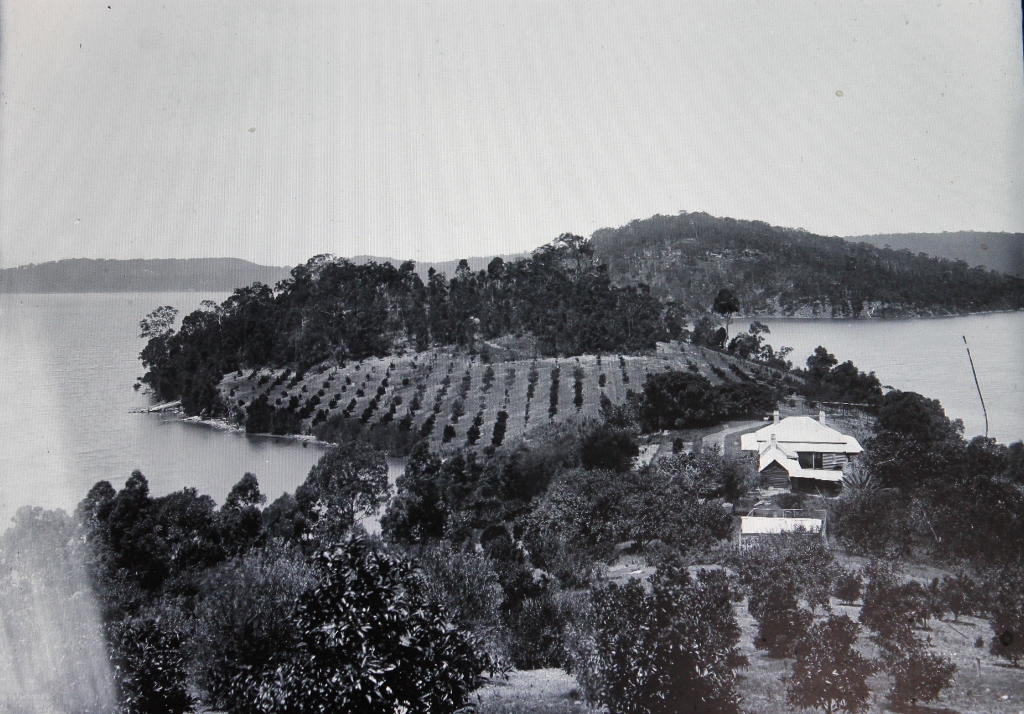
Example of Orange Orchard in Pittwater circa 1910-17 by Charles Kerry, Courtesy Powerhouse Museum and Tyrell Collection.
CHURCH PT, Pittwater-Melrose Accommodation for visitors bathing, boating and fishing. Advertising. (1910, January 1). The Sydney Morning Herald(NSW : 1842 - 1954), p. 17. Retrieved from http://nla.gov.au/nla.news-article15095857
By late 1911 Arthur Morris Simpson, who grew sweet peas on a big scale for which the place became famous, was the owner of the premises with his wife doing the work while he ran a store across the road. Although called ‘Simpson’s Garden Estate’ by Charles Adolphus de Kantzow, who later subdivided the land to sell, it became known from then as ‘The Green Frog’; some state due to the sign at the gate, while later on an actual green frog statue, also placed near the gate, was given as the reason for the namesake. When he and his wife first ran it though, listing it under ‘Country Resorts, the name was still ‘Melrose’;
AT CHURCH POINT, PITTWATER.- MELROSE, Accommodation for visitors; bathing, boat, fishing, poultry, cows; terms moderate. Mrs. A. SIMPSON. Advertising. (1911, December 9). The Sydney Morning Herald(NSW : 1842 - 1954), p. 20. Retrieved from http://nla.gov.au/nla.news-article1529508
Some sources state a Mr and Mrs Johnstone then took over ‘Melrose’ and that the original cottage was demolished. Other sources point to a structure, perhaps renovated further, to be still standing on what is now Pittwater road, was then called Bay View Road, with some original parts of the premises intact.
In February 1923 the property was purchased by Herbert Lionel Somerset Alford ( 5th of November, 1876 – 28th of May 1947) and his wife Ida Mary, nee Griffiths (?- 1970) whom he married in 1908 (registered at Mosman). Mr Alford was the eldest son of Charles George Alford who became a chief in the Bank of New South Wales;
VETERAN BANKER, DEATH OF MR. G. C. ALFORD.
The death of Mr. C. G. Alford, formerly acting manager of the Bank of New South Wales, which took place yesterday, removes one of the most prominent of Australian bankers, says “S.M. Herald " of Wednesday. Mr Alford had been associated with the pioneer bank for 59 years, and his long and varied experience in the banking world has not often been rivalled. Rising steadily from the rank of a junior officer, he attained what he described at a function held on the occasion his retirement, his ambitions-" one thousand pounds a year and 50 years service with the bank." Having reached these goals he set out to achieve, and eventually gained, the honour of recording the longest continued active service in the bank. He entered the service of the institution as a youth a few months before the late Sir John Russell French, who, for many years, was the general manager.
A native of Drayton, Queensland, Mr Alford was 77 years of age, end after receiving his education, entered the service of the bank in Toowoomba, Queensland. The manager of the branch at that time was the late Mr. Robert E White. In the year 1873 he was locum tenens in Toowoomba for Mr. J. J. Walker during a period of about 12 months. During the following year Mr Alford was appointed manager of the bank at Mt. Perry, a copper-mining district near Bundaberg. Later he was assistant manager in Townsville, and also in Warwick. In succession to Mr J. T. Walker, who was appointed general manager of the Royal Bank, Mr Alford took up the duties of manager at the bank in Toowoomba in 1878. He remained in that position until 1885, when he was made assistant inspector and took up his quarters in Brisbane. He came to Sydney in 1891 as inspector, and was afterwards appointed chief inspector. At the time, when the late Sir John Russell French was stricken by illness Mr. Alford acted in the capacity of general manager for about five months.
Mr. Alford lodged a request for voluntary retirement, and the date was fixed tor June 30th, 1921. At the request of the board he remained in the service until permanent arrangements were made.
In private life Mr. Alford had many hobbies. He had a magnificent collection of minerals of which he was very proud, and also a collection of 700 pieces of Australian wood, polished by himself and members of his family. Photography had also a strong attraction for him.
At the function, which took place when he retired, Mr. Alford referred to some interesting incidents in his career, and the striking changes that bad taken place in Australian banking during his period of service. As, mentioned that the bank's assets had increased from £6,000,000 to approximately £75,000,000. while the staff, which numbered about 200 in 1862, had increased nearly tenfold.
During his long service he had experienced several crises, notably the one of 1868, and 1903. During the former, when the panic was at its height, he had seen the £1 notes of the Bank of Queensland-the old Bank of Queensland-sold at a shilling each. Possibly holders parting with so freely imagined the purchasers to be a new class of curio bunters, but they proved to be overdrawn customers of the bank, by whom, of course, the notes were subsequently tendered at face value in liquidation of their debts. In 1893 utility of the banks were closing their doors to which were affixed notices bearing the announcement "Closed for re- construction," but his bank weathered the storm without having to submit to any such humiliation. The times were, indeed, strenuous, but there were stout hearts, for the steep brae. For a period of at least four months following that crash he-and it was the same with many other senior officers, never once left the office much before midnight.
Mr. Alford is survived by three sons. Messrs. H. L. Alford, of Church Point ; L. S Alford, of Gosford and A. C. Alford, of Artarmon ; and one daughter. Miss Ethel Marion Alford. His wife pre-deceased him in 1923. A son, Lieutenant G. B. Alford, died in Loudon in 1916, at the age of 31 years, from wounds received at Pozieres. VETERAN BANKER. (1926, February 10). Morning Bulletin(Rockhampton, Qld. : 1878 - 1954), p. 7. Retrieved from http://nla.gov.au/nla.news-article55255469
Herbert was a man of culture as well. Our research found he helped begin a Philharmonic Society in Goulburn in 1906 and held a position as stipendiary steward with the Australian Jockey Club at Newcastle in 1914. The excellent histories compiled by Peter Altona and Sue Gould, and available on the Church Point Reserve Association website, http://churchpoint.org.au/, point to this gentleman owning four lots of the ‘Simpson’s Garden Estate’ from de Kantzow. Their land comprised Lots 7, 8, 21 and 22. A dwelling on Lot 7 becomes the premises at which the Alfords run their tearooms and boarding house called ‘The Green Frog’.
On 11 November 1929 Herbert Lionel Alford transfers Lot 15 & 15A to Frederick Wymark of Sydney, bookseller. Wymark has a mortgage to Alford which is discharged on 27 December 1933. 1934 On 2 January 1934 Frederick Wymark transfers Lots 15 & 15A to Herbert Lionel Alford (who had owned the lots previously).
The Alfords had one daughter, Jean Agnes, who was active in Mona Vale Golf Club, attending one of their annual Balls at Romanos in town in 1932 as well as organising competitions and fundraising activities;
OPEN EVENT AT MONA VALE. MONA VALE associates are holding their first open competition- Canadian foursome stroke-on October 25 Entries close on October l8 with Miss Alford The Green Frog Church Point ( phone Mona Vale 21) The associations Intend holding open competitions during the summer months and in view of the closeness of the surf these competitions should prove attractive A round of golf and a dip In the surf should be almost Irresistible. OPEN EVENT AT MONA VALE. (1933, September 30). The Sydney Morning Herald (NSW : 1842 - 1954), p. 18. Retrieved from http://nla.gov.au/nla.news-article17011354
MONA VALE GOLF CLUB To raise funds to furnish their- room at 'the clubhouse the Mona Vale Golf Club associates held a bridge afternoon at the Pick-wick Club yesterday Miss Ellis Nicholls was responsible for the organisation and those who arranged tables included Mesdames E Russell Ostman Sidney Potter J W Austin Misses Thelma Austin and Jean Alford. CARD PARTIES. (1932, October 13). The Sydney Morning Herald (NSW : 1842 - 1954), p. 3. Retrieved from http://nla.gov.au/nla.news-article16919607
Church Point was still a lovely rural area during their first decade there, as a complaint to Warringah Council points out;
12. H. L. Alford , 10/10/34, again/complaining of damage to his Cattle property at Church Point by straying stock. (Cattle Straying) 22/10/1934 Warringah Council Minutes
The Alfords were also responsible for an area that has become a green space. This was purchased by Warringah Council; Church Point Reserve J.J Maund and Kelyneck; submitting for completion by Council under Seal (a) Memorandum in respect to purchase from H L Alford Lots 15 and 151, D.P. 10583, Church Points (b) the withdrawal of Caveat lodged by Council -when the time payment agreement to purchase this Land was executed. Resolved, - That the Seal of the Council be affixed to these Council documents. (Crs. Hitchcock, Campbell) 18/03/1941 Warringah Council Minutes
6. Mrs. L. Richards, 15/11/37, requesting that as the road at Church Point is being re-surveyed for widening purposes, Public the Council remove the public lavatories in front of her residence, and place them on the ground purchased from Mr. Alford for recreation purposes. Referred to A. Biding Councillors for consideration and recommendation. 30/11/1937 Warringah Council Minutes
These portions of land are now on the corner of Church Point, opposite the wharf and known as the Quarter Sessions Reserve. The property, still retaining parts of the original structure, was placed on the market in 2006 and again in 2011 for three and a half million. An insight into what it was like to be there;
CHURCH POINT.
(GERTRUDE MACK.)
A Jewel-like spring morning at Church Point. The insistent chant of a butcher bird woke me, calling me out to early service among the trees. I had meant to be very lazy that morning, but once awake, and looking out on the glistening beauty of sea and sky, a bedroom became a dungeon. I quickly dressed, and went out to join the butcher bird.
The previous night I had driven out from Mona Vale, but the night was dark and the car was closed, and I saw nothing of the beauties of sea and hillsides spreading away on either side of the road, along which we drove. I had never been in that part of Pittwater before, and in the crisp light of a brilliant morning the splendid panorama burst with truly dramatic effect. The sun had just risen above the Newport hills and brought a reflecting sparkle from rocks and sea, and red-tipped gum leaves. There was colour everywhere.
Once, in childhood I heard an Englishman say there was no blue in Australian waters. Possibly he had an attack of liver, or perhaps it rained during the one week he was in Sydney, but whatever the cause the remark interested me immensely, and I remember in all innocence asking what colour blue was in other countries? No doubt he thought me a pert little girl, for he did not answer my question, only looked at me with severe disapproval, and my elders frowned. Since then I have seen for myself the blue of many countries, but nowhere have I seen a greater variety of shading than was around me that August morning.
A touch of west wind sharpened the colour and made everything vivid and clear cut. The butcher bird chanted again; he was in the garden, high up in the white cedar tree. The garden was lovely, but I wanted to be out and away from houses and fences, and all that meant restrictions. Quietly I took my way down the winding white steps, and gently opened the narrow green gate, with its guarding frog, and so out into the road.
WHENCE THE NAME.
No one was about; I had the world to myself, and a whole free day before me. A few minutes' walk and I was at the point, and there, some 20ft above the road, and crazily perched on rough stone piles, was the little church, which gave the point its name. Over 50 years ago two devout members of the Methodist Church felt the need of a house of worship when at their week-end homes in the country-and Pittwater was a very long way from the city in those days- and it was due to their efforts that the tiny weatherboard church was built. From long distances the congregation rode on horseback or drove out in sulkies to the Sunday service. Until the last year or so the church has been used regularly, services being hold by ministers of different denominations each Sunday. But It became evident that week-enders feel differently towards tho Sabbath nowadays, and the church is no longer used, and has been allowed to fall into disrepair.
The graveyard, too, is neglected and overgrown with weeds, though here and there a bunch of lately-faded flowers showed remembrance of long dead friends. But the fences are broken, and old graves bidden beneath a tangle of vines. Neglected fences are a depressing sight, but I rather liked the wildness and the tangled vines; they added to the sense of peace, and left the sleepers quiet and undisturbed.
Behind the church a steep, high hill challenged my climbing powers. The air was keen, and encouraged one to physical effort, so I accepted the challenge, for I guessed a picture of uncommon beauty would reward me when the top was reached. The climb was a stiff one, and became more so as I neared the top, and made me very conscious of the thickness of my woollen jumper. Enormous boulders confronted me, which I clambered, or circled round, with the occasional aid of a strong young sapling. On the very summit of the hill was an immense rock; It seemed to have no connection with the surrounding earth, and stood precariously balanced, as though a strong kick would send it hurtling and crashing down the hillside and into the sea.
No doubt geologists could give a simple explanation of its presence there, but to me it appeared to have been hurled from another planet by the band of some angry Titan. I stood upon the top of the rock, saw before me a picture that would have made a climb of twice the distance well worth while.
KURING-GAI CHASE.
From my high altar I looked across the water to Kuring-gai Chase, extending dark and undulating for many miles. Building is prohibited there now, but some early houses still remain. One of them to the left of the point, was built years ago by an artist who had lived In Italy. He was enchanted by the resemblance to the much-loved land of his youth, and every Friday saw him and his Italian wife, well supplied with olive oil and macaroni, on their way to the Chase.
Week-ending was not then the common-place it has since become. There were no trams out from Manly; motor cars were unknown, and the journey and matter of provisions were something of an undertaking. But they always went, and for two whole days memory bridged the distance between Australia and the Italy they know so well.
As I looked at the richly dark hills, and not yet spoilt by progress and land agents, the cobalt blue of the sea, paling into turquoise where it lapped on little crescent beaches, I could see why our Italian friends had been enchanted with the place. If scenery alone were the lure of travel, there would be no need to go far beyond Australian waters. Fortunately for shipping companies something more is needed. Restlessness is hard to satisfy.
Away to the right a fleet of white yachts looked, in the distance, like a huge cluster of sleeping swans. Beyond them, scattered red roofs added to the effect of a painted scene.
"The whispering waves were half asleep,
The clouds were gone to play,
And on the bosom of the deep
The smile of Heaven lay."
Presently one of the sleeping birds began to stir, to slowly stretch long pointed wings above the shimmering water, then with a big shuddering yawn she was fully awake, and swinging out before the rising breeze And now the rest was disturbed, and one by one wings were stretched, and the blue sea was soon dotted with great white birds.
Something within told me the hour was getting late. My bird congregation had dispersed, the service was over. I heard, too, the tooting of motor horns, and knew I no longer had the world to myself, the Sunday procession of motor cars had commenced.
A downward track led to some charming gardens. Brilliant oranges amid glossy leaves caught the sunshine, smiling wattles, and the soft fresh red of poinsettias glowed above emerald green lawns. And over all was the azure sky. The contrasts delighted the eye, but still more delightful just then, though not to the eye was the odour of frizzling bacon.
The morning skies had not ' knocked on my sullen heart in vain," and better still they had given me a fine appetite for my belated breakfast. CHURCH POINT. (1927, September 10). The Sydney Morning Herald (NSW : 1842 - 1954), p. 8. Retrieved February 4, 2012, from http://nla.gov.au/nla.news-article16403005
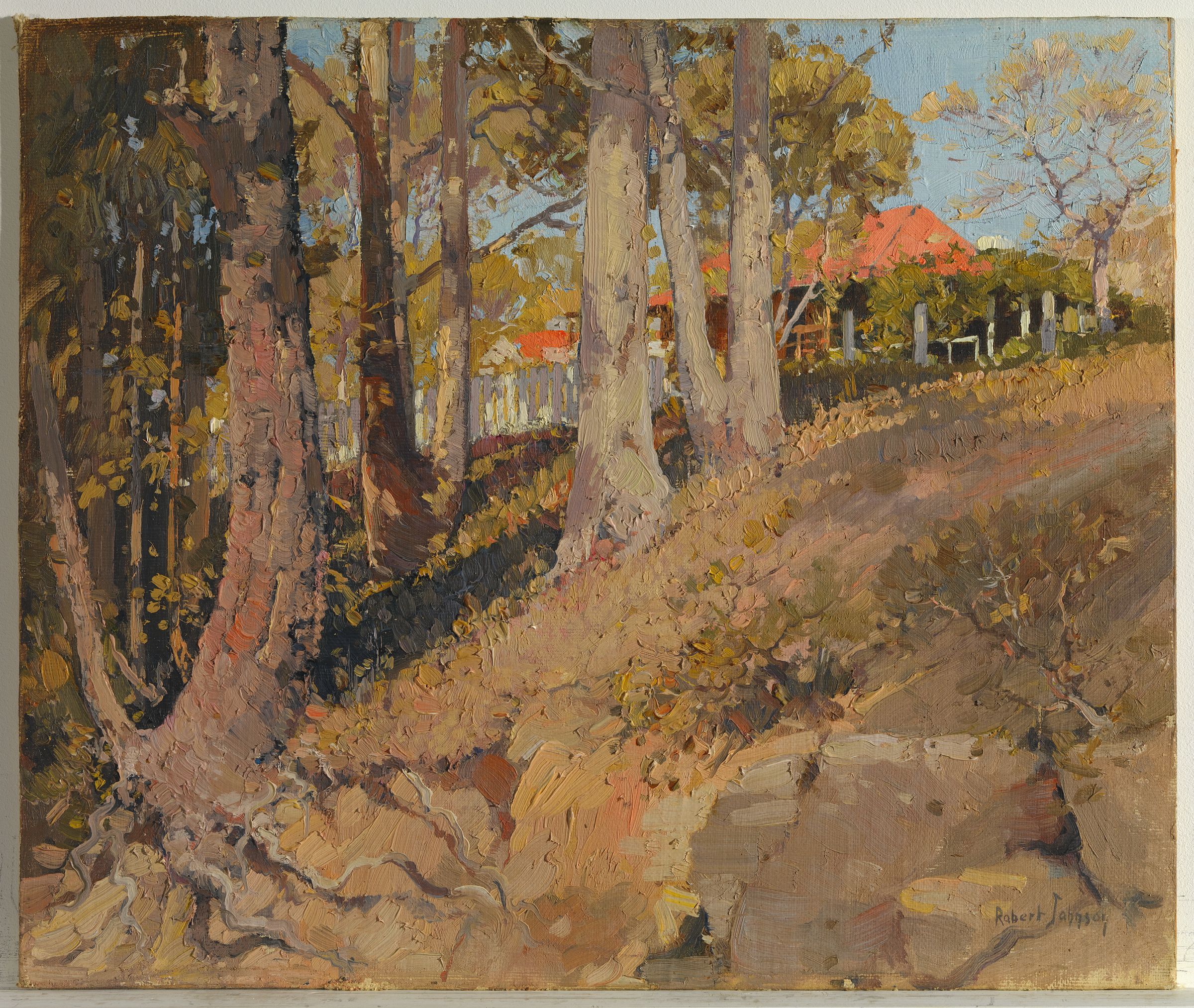
Robert Johnson, At the Old Green Frog, Church Point, circa 1927 - courtesy National Gallery of Australia
Mack, Gertrude (1880–1937)
Miss Gertrude Mack, whose death occurred at a private hospital in Darlinghurst on Wednesday, was a sister of Miss Amy Eleanor Mack (Mrs. L. Harrison), the well-known short-story writer, and had made a name for herself as a journalist and short-story writer both in Australia and abroad. Miss Mack, who returned to Australia three weeks ago from London, on a visit to her brother, Mr. C. A. Mack, of Mosman, was the youngest of the five daughters of the late Rev. Hans Mack. She was born at Morpeth, New South Wales, and as a child lived at Windsor and Balmain and later at Redfern. She was educated at Sydney Girls' High School.
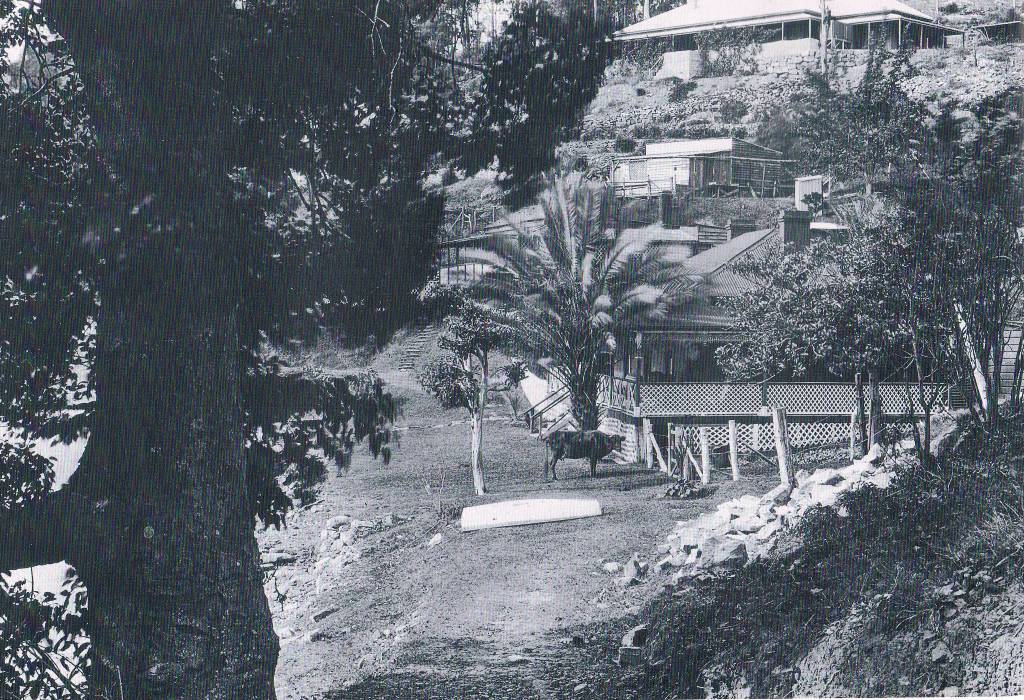
Church Point, circa 1914
A QUAINT FASHION. Animals and Teahouses. (BY MARGT. GYBBON.)
Animals and birds have a queer way of giving a special character to a place, and many people have had the fascinating idea of calling a resthouse, or an Inn, or a refreshment room, far out in the country, by the name of one.
In the old days the Black Horse at Richmond was famous, and there many a good pint of beer was quaffed by thirsty travellers, horsemen all. Coaches and buggies drew up at the doors then, and ladies, riding postillion, dismounted to shelter on the verandahs. At least let us hope they had a rest while their menfolk drank. For postillion Is a mighty uncomfortable way to ride, as the writer can testify. Motoring is much more pleasant, if not so good for the figure. And nowadays, instead of the Black Horse or The Dog and Duck, we have The Green Frog, The Black Cat, or The Golden Goat and The Gay Parrot. Moreover, we rush out to our destination and back in a few hours.
Most people know the Green Frog at Church Point, Pittwater, with its exquisite terraced garden, its lawn, its cedar tree overlooking that vast inland sea. And if you have never been there on a summer's afternoon, or a moonlight night, with the moon's silvery path-way coming almost to the steps of the garden, it is time you went. Jonah's is not far away over at Newport, and I can't help wondering if there is not a whale in the vicinity. A QUAINT FASHION. (1931, January 17). The Sydney Morning Herald (NSW : 1842 - 1954), p. 9. Retrieved from http://nla.gov.au/nla.news-article16746626
This painting is not on display where we can see it at present; hopefully someone will organise an Art Exhibition of Historical Pittwater paintings soon; each aspect of Pittwater, and its changes, have been captured by artists lone gone and still here;
ART EXHIBITION. MR ROBERT JOHNSON'S LANDSCAPES. Mr. Robert Johnson, who has an attractive collection of landscapes on view at the Grosvenor Galleries, George-street, displays in these oil painting, a fine feeling for colour and composition. There is a brilliant texture, as well as individuality. In "At the Green Frog, Church Point," a sun-splashed scene near Newport, in which the steep, rocky slope and the trees to the left all converge naturally to the red-roofed house on the hill, the central point of Interest. ART EXHIBITION. (1927, August 30). The Sydney Morning Herald (NSW : 1842 - 1954), p. 12. Retrieved from http://nla.gov.au/nla.news-article16400523
PAINTING AT OLD GREEN FROG CHURCH POINT' BY ROBERT JOHNSON(1890-1964); purchased by Federal Government; $ 8,500 oil on cardboard mounted on board, 37.0 x 45.0 cm now at National Gallery of Australia, Canberra. Copy of this, courtesy of the NGA, above.
Mr Alford passed away in 1947;
ALFORD, Herbert Lionel.-May 28, 1947, at his residence. The Green Frog, Church Point, loved husband of Ida Mary, and father of Jean. Privately cremated 30th Instant. Family Notices. (1947, May 31). The Sydney Morning Herald(NSW : 1842 - 1954), p. 38. Retrieved from http://nla.gov.au/nla.news-article27900519
Jean, who had married in 1945, may have helped her mother continue to run The Green Frog
Green Frog Church Point open for teas all day Saturday and Sunday. If teas wanted on week days please ring XW9021. Advertising. (1949, September 1). The Sydney Morning Herald(NSW : 1842 - 1954), p. 10. Retrieved from http://nla.gov.au/nla.news-article18126560
For sale; CHURCH POINT The Green Frog Freehold Home business XW9021 Advertising. (1954, March 17). The Sydney Morning Herald(NSW : 1842 - 1954), p. 21. Retrieved from http://nla.gov.au/nla.news-article18414898
The Green Frog is now a private residence.
 |
Green Frog at Church Point Research - Messy.pdf Size : 311.855 Kb Type : pdf |
Extras;
From Shelagh and George Champion OAMs (7.1.2013):
Bellemere-Melrose is one property, while The Green Frog is an entirely separate property. This became very clear to me when I researched the Church Point land in the Land Titles Office. The Melrose property was transferred by Ben. James to Philip Charley on 22 December 1890; then by Charley to Arthur Morris Simpson on 30 August 1911; and then by Simpson to Mrs Ada Ellen Pritchard on 22 December 1915. It remained in the Pritchard family as a private residence.
The Green Frog property (lots 7, 8, 21 and 22 with a house on lot 7, on the attached map) was transferred by Simpson to de Kantzow and then to Herbert L. Alford and his wife on 4 February 1923, and remained the property of the Alfords.
The attached map makes this clear. The illegible writing on the coastline reads: Burton's boat shed and tea room, Church Point Wharf, and Post Office & store.
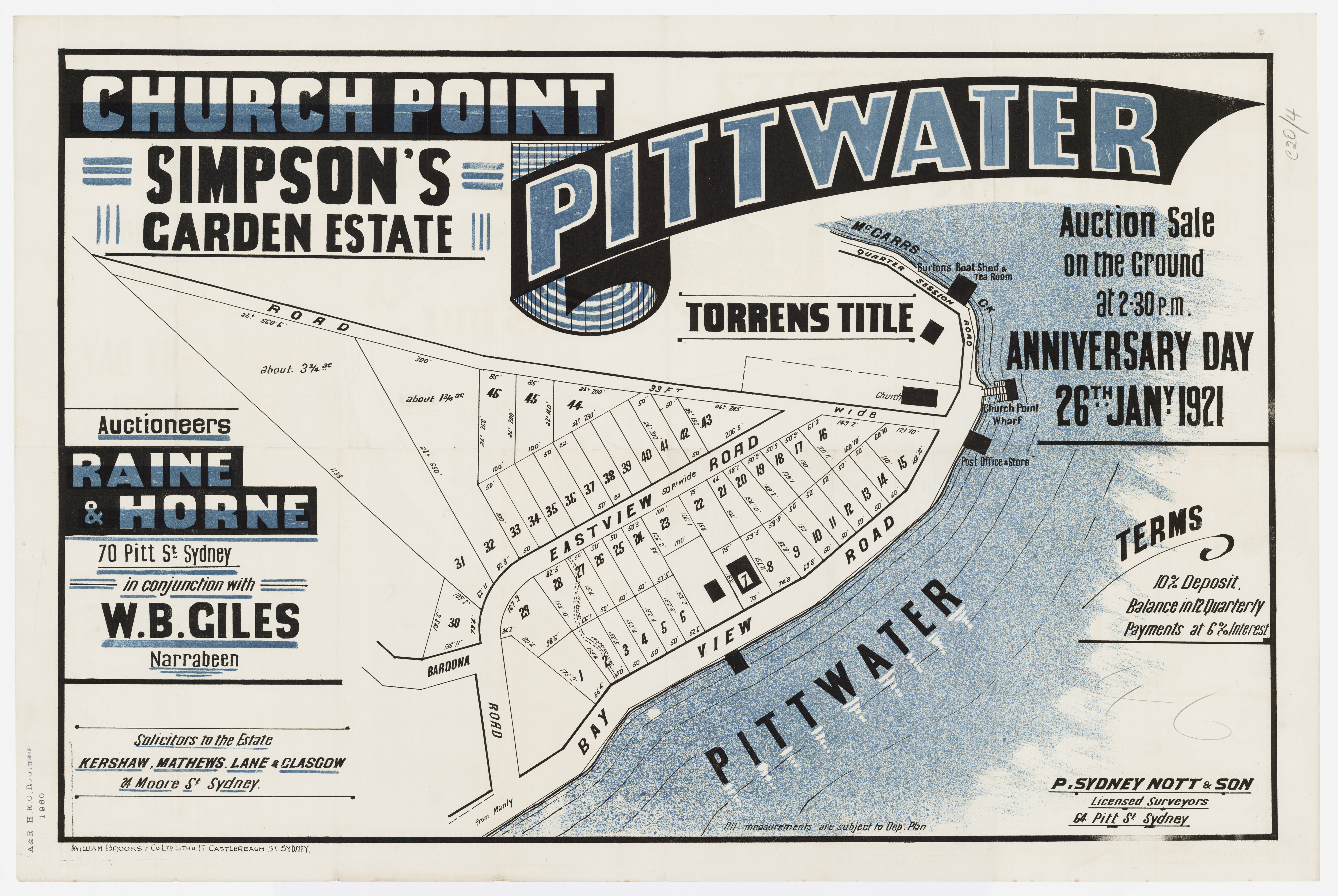
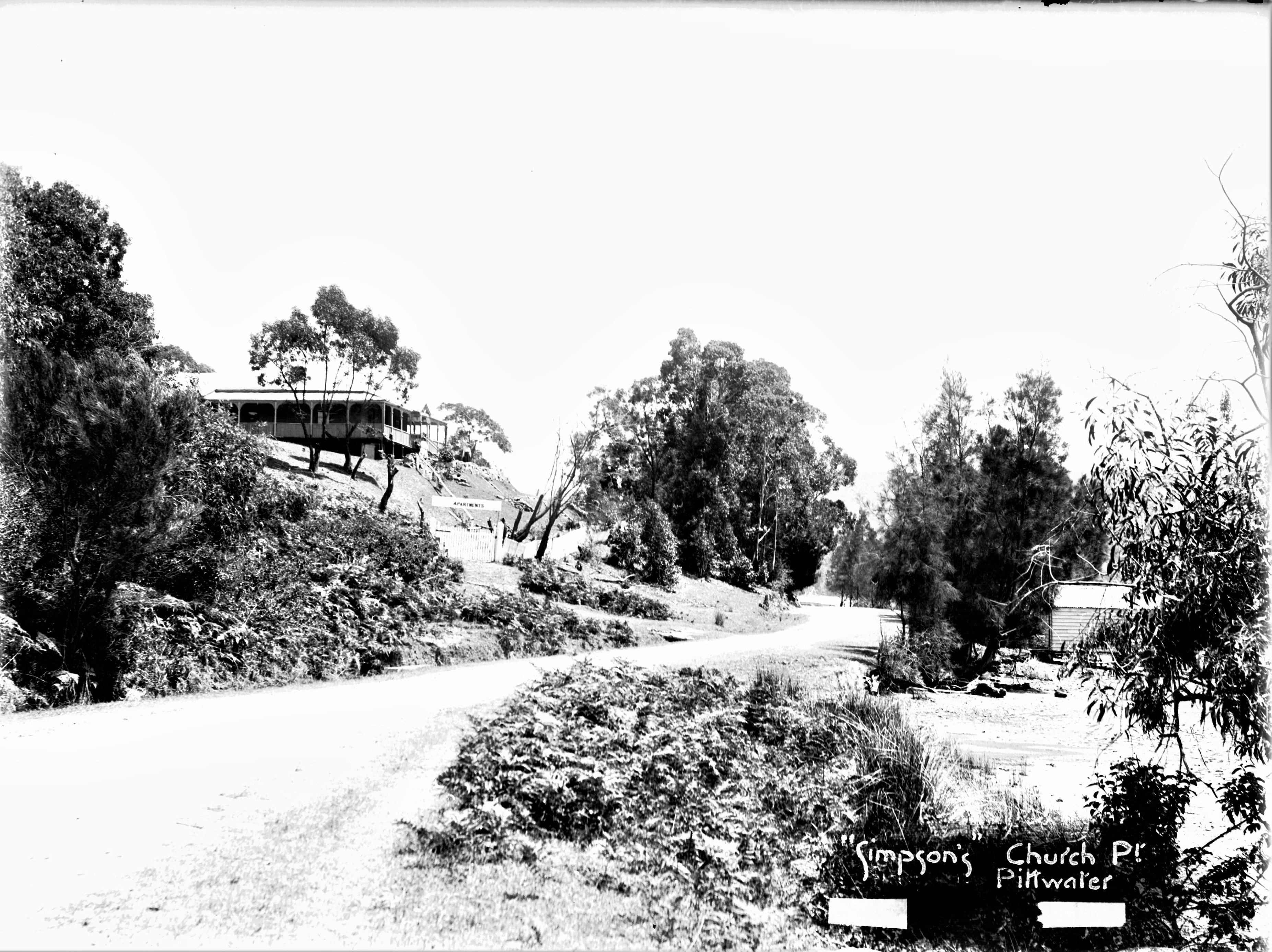
''Simpsons'' Church Point, circa 31/12/1908, from State Records & Archives NSW pictures, Item No.: FL12991
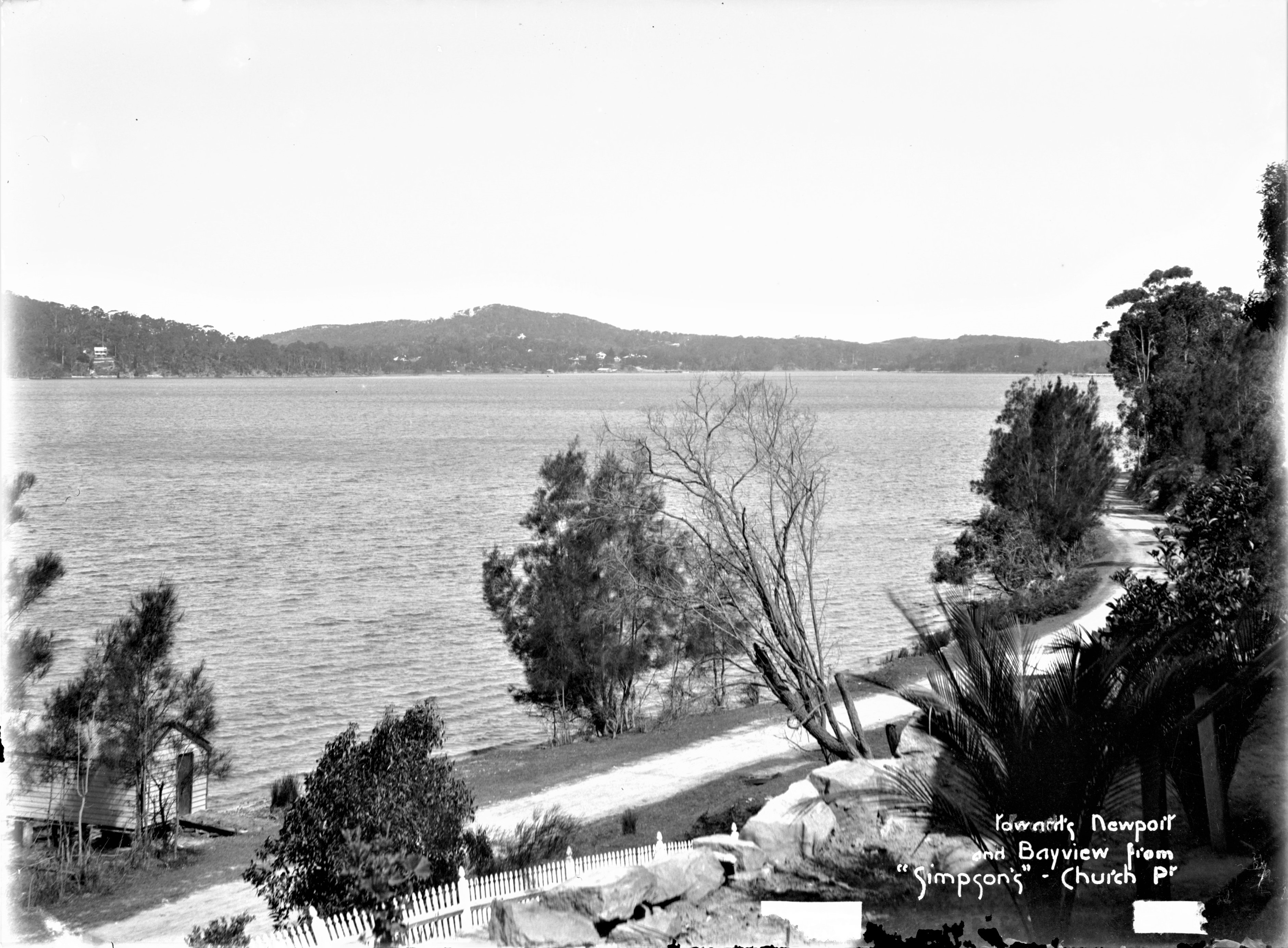
Towards Newport and Bayview from ''Simpsons'' Church Point, circa 31/12/1908, from State Records & Archives NSW pictures, Item No.: FL13043
Benjamin James and Benjamin James Jnr. Department of Lands, Sydney. June 1, 1885. APPLICATION TO PURCHASE RECLAIMED LAND. (Newport Bayview House)
ATTENTION is invited to the notice in the Government Gazette of the 22nd May, 1885, calling for objections (if any) to the application of BENJAMIN JAMES, Jun., to purchase reclaimed land in front of his property at Pittwater, parish of Narrabeen, county Cumberland. CHARLES OLIVER, Under-Secretary. Department of Lands, Sydney. June 1, 1865. APPLICATION TO PURCHASE RECLAIMED LAND. (1885, June 3). The Sydney Morning Herald (NSW : 1842 - 1954), p. 2. Retrieved from http://nla.gov.au/nla.news-article13590040
Bought from Daniel Farrell: witness then had property worth £5000 ; that property was sold through Hardie and Gorman to Mr. Benjamin James ; witness had spent the proceeds of the sale; his bank account would show how he expended the money; the property consisted of 110 acres of land at Pittwater, which witness bold to Benjamin James at £22 per acre ; INSOLVENCY COURT—FRIDAY. (1887, October 22). The Sydney Morning Herald (NSW : 1842 - 1954), p. 7. Retrieved from http://nla.gov.au/nla.news-article13677542
Major Phillip Charley
Philip George Charley, (1863–1937)
by Hilary Weatherburn
Sir Philip Belmont Charley (1893-1976), dairy farmer, was born on 28 December 1893 at Belmont Park, Richmond, New South Wales, third child and eldest son of Philip George Charley (1863-1937), a Victorian-born horse- and cattle-breeder, and his wife Clara, née Ewens, from Adelaide. Philip senior belonged to the original seven-man Broken Hill syndicate. He sold half his shares in 1886 and in 1891 purchased the historic property of Belmont at Richmond Hill, where he built an Italianate sandstone mansion, and imported, bred and exhibited Cleveland Bays, English hackney horses, Norfolk red polled cattle, and Lincoln and Shropshire sheep. The holder of extensive properties, Charley was president of the Hawkesbury District Agricultural Association, and a vice-president of the Royal Agricultural Society of New South Wales and of the Hawkesbury Benevolent Society and Hospital. He died at Rose Bay on 31 August 1937; his wife, five sons and three daughters survived him.
Hilary Weatherburn, 'Charley, Sir Philip Belmont (1893–1976)', Australian Dictionary of Biography, National Centre of Biography, Australian National University, http://adb.anu.edu.au/biography/charley-sir-philip-belmont-9733/text17189
SQUIRE OF BELMONT Sixty-one Last Sunday B.H.P. REMINISCENCES
On Sunday last Major Philip Charley celebrated his sixty first birthday, an event which recalls the discovery of Broken Hill, one of the greatest silver mines in the world.
As a youth Philip Charley was engaged as a law clerk in Melbourne, but a threatened lung trouble diverted him to the bush, and through the intervention of a friend he obtained employment as a station hand at Mount Gipps station, on which the famous Broken Hill Mine was discovered in the early eighties, says the "Sunday News."
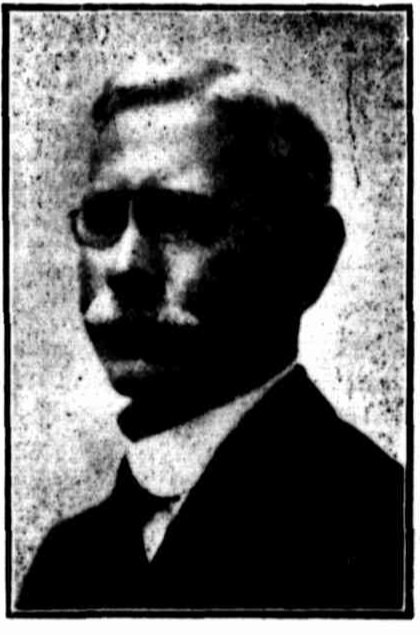
"It required some courage, too, to hold on in those early struggling days,” remarked the Major, "because the majority of our small syndicate were poor young chaps, who had never had much money, and when the speculators came along juggling their bags of sovereigns, it was very tempting. But, somehow I always had faith in the place, and it was not long before my faith was rewarded."
When the success of the great silver mine was assured Mr. Charley made a tour of Australia in search of a place to settle down, and eventually selected Belmont Bark, a beautiful site, at North Richmond, at the foot of the Kurrajong Heights, and overlooking one of the picturesque reaches of the Hawkesbury River.
Giving his architect a free hand for the erection of a modern homestead, Mr. Charley, still a young man, took a two years' tour of England and the Continent, where, with the assistance of his wife he selected the furniture and art treasures for their future home.
A great lover of horses, Major Charley, on his tour of the world, decided to establish a high-class English hackney stud in Australia. One of his first purchases was Vanity Fair, the premier hackney stallion of his day, and a week or so later he acquired Moncrieffe Statesman from Lord Moncrieffe. In Scotland. The former owner of Vanity Fair pursued Major Charley all over Scotland with extravagant offers to re-purchase the horse, explaining that he had only parted with him because he had information that Moncrieffe Statesman was for sale.
It was as one of the founders of the Hawkesbury Light Horse that Major Charley gained his military title, and his two -older sons. Philip and Jack, saw active service in the Great War, practically from beginning to end. For 22 years Major Charley has been president of the Hawkesbury District Agricultural Association. Perhaps one of the finest tributes ever paid to the Major was that told by an old resident to a "Hawkesbury Herald" representative recently during a friendly chat. "The thing about young Charley," he said, "was his absolute trustworthiness even as a young man. 'If Major Charley said it then it’s true,' was admitted as a sufficient backing for any fact used in the days when the world was wide." SQUIRE OF BELMONT. (1924, September 25). Hawkesbury Herald (Windsor, NSW : 1902 - 1945), p. 1. Retrieved from http://nla.gov.au/nla.news-article66366335
'Belmont Park' '
'BELMONT Park,' North Richmond, has been sold by private treaty to the Hospitaller Brothers of St. John of God for £15,000. FORMERLY the home of the late. Major Phillip Charley, 'Belmont Park' is situated on a hill with a commanding view of the Nepean River. Thirty years ago it was at its best with beautifully laid out and well tended gardens, which set off the mansion to perfection. It was furnished with priceless pieces and was a centre of social life. It was unoccupied for sometime after Major Charley moved to Rose Bay. The sale was made by Richardson and Wrench on behalf of Mrs. M. Macdonald, who has been the owner for some years. "Belmont Park" sold. (1951, November 7). Windsor and Richmond Gazette (NSW : 1888 - 1954), p. 5. Retrieved from http://nla.gov.au/nla.news-article86059551
RED-POLLED BULLS FOR CENTRAL QUEENSLAND.
By the s.s. Darwah, which arrived on Monday from the south. Messrs. Dalgety and Co. received three very fine red-polled stud bulls, the progeny of noted prize-winners, on account of Mr. John Orr, of Laurel Bank. These animals were purchased from Major Phillip Charley, of Richmond, New South Wales, who is recognised as the premier breeder of red polls in Australia, and should prove a. very valuable addition to Mr. Orr's already fine stud of red polls. RED-POLLED BULLS FOR CENTRAL QUEENSLAND. (1914, June 10). Morning Bulletin (Rockhampton, Qld. : 1878 - 1954), p. 6. Retrieved from http://nla.gov.au/nla.news-article53336658
Bellemere-Melrose-The Green Frog threads collected and collated by A J Guesdon, 2012.
|
|